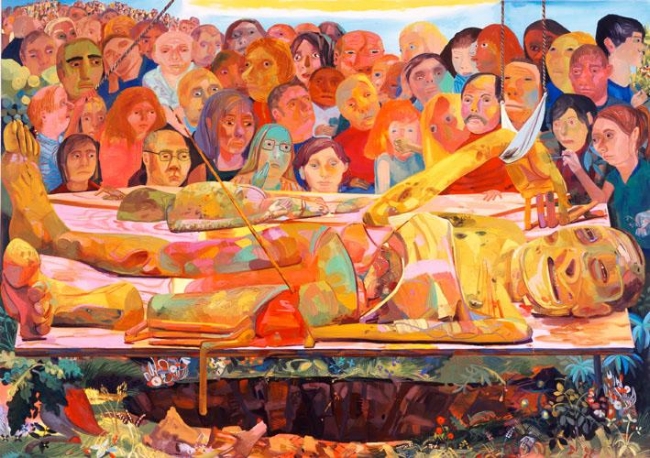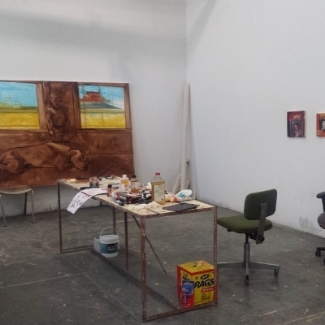New Changes at the Detroit Institute of Arts
Mario Moore
The Detroit Institute of Arts is a place I consider my second home. I grew up exploring the galleries as a kid. There’s excitement and familiarity when I walk into the Grand Hall and make my way to the Diego Rivera murals. I had one of my first jobs at the Detroit Film Theatre, which is a part of the museum. I have worked many different positions in the DIA—from the education department to inventory control. I have seen the in-house storage as well as the off-site storage building for the institution and I can tell you the collection is massive. The DIA has always been a part of my life, which is why I am closely watching when any new announcements are made regarding the museum. As a former employee and an artist who has benefited from the museum's programming, I have an interesting perspective of the DIA.
Big changes are announced in news stories every other week. It feels like the DIA’s new Director, Salvador Salort-Pons, is taking the museum to new heights and I’m pretty optimistic about its direction—the recent 5 million dollars that’s been allocated specifically for purchasing African and African American art; the new Contemporary Art Curator, Laurie Ann Farrell and two new assistant curators, Lucy Mensah and Taylor Renee Aldridge (I already know Taylor is going to bring her knowledge to this gig).
These changes have made me hopeful that the museum will move forward in ways that introduces new work to the public. I’m not talking about something that is self-beneficial; I’m talking about the possibility of what can happen at the DIA. When the recent funds for African-American Art were announced, the first purchase made was a David Hammons piece that cost somewhere between $1 million and $1.5 million dollars.
Don't get me wrong, I believe having Hammons in the museum is truly amazing, but what happens next is more important. I like to think of the museum as a place of excitement, learning and reflection. If you walked through the current Contemporary Art galleries, it would look and feel like you were stuck in the 20th century. Of course there are staples like Warhol, Alex Katz and others but these galleries have been pretty stagnant since the reopening of the museum. Upon hearing that the new Contemporary Art curator wants to have a Yoko Ono show, I wasn't impressed. I'm tired of seeing the same names being presented by museums. Sorry not sorry. I believe this museum can take a new direction and include artists that are bringing new experiences and voices to Contemporary Art.
Now I know I am talking about two separate departments and I haven’t a clue what the funds are for the Contemporary Art department but I believe this department is in a position to bring home some of its contemporary greats. As a museum, I totally get that it has to collect and show artist that have long arching careers but what about those artists that are currently changing the way we see art and ourselves. I believe it would be dope if the DIA considered artists from Michigan that are killing the art world game right now.
Dana Schutz–an artist born in Livonia, Michigan—is someone to consider. While I was in grad school at Yale she conducted studio visits and we had a chance to speak. She told me that the first artist studio she visited while in school was the Detroit great, Gilda Snowden. Now for those readers who are not from Detroit, look her up. For those who are familiar with the Detroit art world, you already know Gilda was an art giant and her passing left a void in the city. How great would it be to have such an amazing painter, who said Gilda Snowden's studio visit made her open her eyes to the possibilities of art, in the collection of the DIA.
Dana Schutz, Presentation, 2005, Oil on canvas, 120 x 168 in
Another name I’ll add to the mix is Titus Kaphar, a Kalamazoo, Michigan-born artist. Both Schutz and Kaphar are relevant, exciting artists that would reflect the city and surrounding areas of Detroit, Michigan. These are big names and as a museum, you have to have the staples—the standards the art world approves of but the DIA could move in another direction in collecting new, young contemporary artists.
Titus Kaphar, Behind the Myth of Benevolence, 2014, oil on canvas, 72 x 60 inches
All the artists don’t have to have a connection to the city, of course, because when thinking about a museum like the DIA, it has a responsibility as one of America’s greatest museums to present the world of art to the citizens of Michigan. But just for the sake of showing how much talent has come from and is still inside Detroit here are two young artists to consider: Kevin Beasley, who currently lives in New York, who attended the College for Creative Studies in Detroit for his undergraduate degree and has shown at MOMA and the Whitney Museum. Tiff Massey, an alum of Cranbrook Academy of Art, recently received a Kresge Grant and creates amazing sculptures and jewelry. Their work would be great additions to the museum collection or even curated shows. Other exciting rising and established artists that would be an asset to the DIA: Erick Mack, Jennifer Packer, Lynette Yiadom-Boakye, Senghor Reid, Patrick Earl Hammie, Anita Bates—the list goes on.
Kevin Beasley, Unititled (shrink), 2016, Resin, house dresses, kaftans, wood, 66 × 64 × 20 in
Tiff Massey, Vanity
Like I said, a museum has to think broader. I hope that the DIA’s GM Center for African American Art, which represents one of the first curatorial departments dedicated solely to African American art at any major art museum will not just load up on artists comparable in cost to David Hammons but that the new changes happening in the museum will also consider new, young artist with powerful voices that are creating exciting work.








